More dronestock Photos and Videos from Bali available to license for all your audiovisual projects
The post Aerial View Of Pura Tanah Lot Temple And Beach At Sunset, Filmed By Drone, Bali, Indonesia on HOsiHO.com appeared first on DRONESTAG.
More dronestock Photos and Videos from Bali available to license for all your audiovisual projects
The post Aerial View Of Pura Tanah Lot Temple And Beach At Sunset, Filmed By Drone, Bali, Indonesia on HOsiHO.com appeared first on DRONESTAG.
As the Drone Girl, I’m always getting questions from new pilots! This one answers whether I need to register my drone again if I’ve bought it from a reseller. To help me answer this one, I’ve enlisted the help of Patrick Sherman. Like me, he’s a long-time drone enthusiast who has risen to become a professor at Embry-Riddle Aeronautical University specializing in, you guessed it, drones!
One reader wrote in to say: Hello, I purchased a like-new DJI Phantom 4 Pro V2, the seller had the drone activated with DJI and FAA registered. The drone has the FAA Registered label. The seller made no effort to un-register the drone or remove his name, or to wipe the SD card. Should I ask the seller to un-register the drone with the FAA? Or just register the drone myself with the FAA?
I asked the seller and he wants me to provide the drone serial number and FAA register number. I don’t trust the seller much now after sale stuff, but should I use his help or now worry much about it? Thanks for any help with this topic.
Patrick Sherman, who is also the author of the book “Getting Started with Drones and Model Airplanes” knows a thing or two about launching a drone business. Given that, I asked him to help me answer this question
Here was his response (and if you want more of his insights, grab a copy of his book today!):
You’ve actually got a couple of different issues you need to sort out with the original owner of the aircraft. Let’s look first at the question of FAA registration, before diving into your questions around wiping the SD card.
According to the FAA, when a drone leaves your possession – either because it is lost, sold, or retired from service – you are required to un-register it on the FAA DroneZone website. And, indeed, it is in the former owner’s best interest to do so. Here’s why:
Let’s say you’re the new owner and you lose control of the aircraft and send it careening into the local high school marching band. People get hurt and instruments are damaged. When the FAA investigates, the first thing they are going to look at is the registration number on the aircraft – and then they are going to knock on the door of the person attached to that registration number, and they likely aren’t going to be in a forgiving mood.
So, the person who sold you this aircraft should be anxious to un-register it from their FAA account. Otherwise, they lack a fundamental understanding of the concept of legal liability.
Once the aircraft is in the clear, you can register it like a new aircraft under your own account.
Something else you need to worry about is if the aircraft is registered to you in the DJI database. Obviously, this doesn’t have any particular legal consequences associated with it. However, if the aircraft ever requires service, if you need to unlock airspace or something else along those lines, you’ll need to be the registered owner with the company that built the thing. So, find out the status of that, as well.
Related read: How do I sell my used drone?
Finally, as regards the SD card – format it. Unless there is some really gorgeous imagery on it. Then, it would be polite to contact the seller and make sure they have a copy before it vanishes into digital limbo forever.
Be well!
-Patrick Sherman
Are you starting out as a remote pilot? Do you have other questions you’d like Patrick to answer? The chances are that he already has answered it! Check out his new book, “Getting Started with Drones and Model Airplanes,” published by Aviation Supplies & Academics – the leading publisher of aviation-related books in the United States. Copies are available on Amazon!
If you have a question for Drone Girl, contact her here.
The post I bought a used drone. Do I need to register my drone again? appeared first on The Drone Girl.
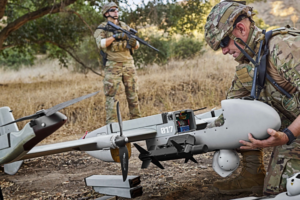 – AeroVironment has introduced the P550 advanced autonomous Group 2 eVTOL uncrewed aircraft system designed to set a new standard for battlefield adaptability and operational readiness. Leveraging a Modular Open Systems Approach (MOSA) and AI-driven autonomy, P550 is engineered to empower maneuver forces to quickly respond to evolving mission demands with rapid deployment, scalability, and […]
– AeroVironment has introduced the P550 advanced autonomous Group 2 eVTOL uncrewed aircraft system designed to set a new standard for battlefield adaptability and operational readiness. Leveraging a Modular Open Systems Approach (MOSA) and AI-driven autonomy, P550 is engineered to empower maneuver forces to quickly respond to evolving mission demands with rapid deployment, scalability, and […]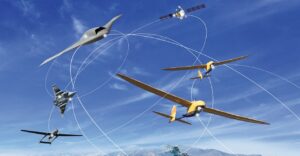 On 16 October 2024, in the first flight tests of their kind, Thales demonstrated the potential of deploying swarms of drones with different levels of autonomy. Autonomous functionality optimised by Artificial Intelligence (AI) and intelligent agents reduces the cognitive load on operators yet ensures that they remain in control at all times, particularly during critical […]
On 16 October 2024, in the first flight tests of their kind, Thales demonstrated the potential of deploying swarms of drones with different levels of autonomy. Autonomous functionality optimised by Artificial Intelligence (AI) and intelligent agents reduces the cognitive load on operators yet ensures that they remain in control at all times, particularly during critical […]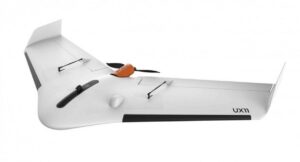 On Wednesday, October 16, French Minister of the Armed Forces Sébastien Lecornu announced the first delivery of French-made kamikaze drones to Ukraine in the coming weeks. Lecornu detailed that the aerial drones for transfer were manufactured by Delair, have successfully passed all performance tests, and will be soon adopted by both the French and Ukrainian […]
On Wednesday, October 16, French Minister of the Armed Forces Sébastien Lecornu announced the first delivery of French-made kamikaze drones to Ukraine in the coming weeks. Lecornu detailed that the aerial drones for transfer were manufactured by Delair, have successfully passed all performance tests, and will be soon adopted by both the French and Ukrainian […]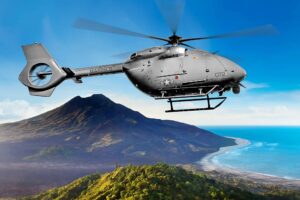 – Airbus recently completed its first program demonstration in support of the U.S. Marine Corps Aerial Logistics Connector contract at Marine Corps Air Station New River and Marine Corps Base Camp Lejeune. The demonstration evaluated the performance characteristics of the UH-72B Lakota platform, validated the aircraft’s ability to carry specialized cargo, showcasing Airbus’ approaches to […]
– Airbus recently completed its first program demonstration in support of the U.S. Marine Corps Aerial Logistics Connector contract at Marine Corps Air Station New River and Marine Corps Base Camp Lejeune. The demonstration evaluated the performance characteristics of the UH-72B Lakota platform, validated the aircraft’s ability to carry specialized cargo, showcasing Airbus’ approaches to […]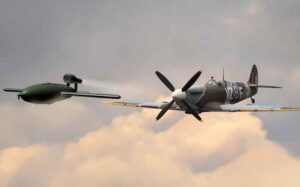 On June 13, 1944, the citizens of London awoke to an eerie but puzzling buzz approaching the city. The morning stillness was shattered when the buzzing stopped and a strange aircraft plummeted from the sky, hitting a railway bridge and unleashing 1,800 pounds of explosive force. The bizarre aircraft was a German-made Vergeltungswaffen (“vengeance weapon”) […]
On June 13, 1944, the citizens of London awoke to an eerie but puzzling buzz approaching the city. The morning stillness was shattered when the buzzing stopped and a strange aircraft plummeted from the sky, hitting a railway bridge and unleashing 1,800 pounds of explosive force. The bizarre aircraft was a German-made Vergeltungswaffen (“vengeance weapon”) […]If you’ve been eagerly awaiting the release of DJI’s Air 3S in the U.S., you may have noticed it’s been unusually difficult to get your hands on this drone. For now, it’s available on DJI.com. But for customers seeking to shop from a third-party, say, Amazon (which is a popular pick, particularly for Amazon Prime members who can get an additional 5% back by paying with their Amazon Prime Rewards Visa Card), it’s made for a tough dilemma.
Order the DJI Air 3S directly from DJI? Wait it out and buy from a trusted third-party? And if that second choice, how long will the wait be?
Here’s the low-down on the holdup with the DJI Air 3S shipping – and the rather odd reason behind it.
While DJI dominates the American consumer drone industry, recent issues with U.S. Customs and Border Protection (CBP) have made it increasingly difficult for consumers to get their hands on DJI drones. Most notable among them? The Air 3S, which DJI announced earlier this week to much anticipation (and subsequent disappointed from people who wanted to buy it from their favorite retailers on day 1).
So what are the reasons for these delays? It’s a mix of complex geopolitical tensions and U.S. legislative action.
At the center of the issue is the Uyghur Forced Labor Prevention Act (UFLPA). The law, passed in 2021, was designed to prevent products made with forced labor from entering the U.S. market. The UFLPA als presumes that goods sourced from China’s Xinjiang region (where the U.S. alleges widespread forced labor abuses) are essentially “guilty” unless proven otherwise. And with it, the law gives the CBP wide authority to withhold products at the border. That’s even if there’s no hard evidence — merely suspicion of involvement with forced labor.
And it’s that very law that U.S. customs has cited as the reason for holding up imports of select DJI drones, including the Air 3S. That’s according to a post on DJI’s own blog, as well as corroborated by letters sent to DJI authorized distributors.
In the DJI blog post, the Chinese-based company said that the CBP is scrutinizing the company’s compliance with the UFLPA. Though, DJI also firmly rejected any claims of forced labor in its supply chain. DJI says that it has no operations in Xinjiang (the region targeted by the UFLPA) neither in terms of manufacturing nor in terms of sourcing materials. DJI says its manufacturing is based in Shenzhen (that’s also where the DJI headquarters are) as well as Malaysia.
According to DJI, the company adheres to both U.S. law and international labor and manufacturing standards. That includes adherence to Section 307 of the Tariff Act of 1930 (19 U.S.C. §1307), which prohibits importing any product that was created either wholly or in part by forced labor. It also includes adherence to 22 U.S.C. §6901, which specifically applies to products made in China.
DJI also holds the ISO 45001 certification, which is a worldwide, international standard for occupational health and safety.
Sure, we haven’t verified every minutia of DJI’s supply change. But, the company says its top U.S. retailers do conduct rigorous due diligence audits.
Related read: What’s it like being a Chinese drone company right now?
The news comes at a time that feels not coincidental. Because while DJI is in the midst of these customs issues, broader U.S. government efforts to curb the use of Chinese drones are also intensifying.
Just last month, the U.S. House of Representatives voted to bar new DJI drones from being used by federal agencies, citing concerns over data privacy, surveillance, and national security. That’s H.R. 2864, the Countering CCP Drones Act. That would add DJI too the Federal Communications Commission’s (FCC) Covered List, in turn prohibiting new models of DJI drones from operating on U.S. communications infrastructure.
The bill is now awaiting action in the Senate, where it could be added to the Senate version of the 2025 National Defense Authorization Act (NDAA).
Read more: What happens if Congress bans DJI drones?
Though, that bill doesn’t have anything to do with labor practices, but rather fears about data security.
“I am proud to have advanced legislation this week to combat unfair Communist Chinese trade practices, prevent Communist Chinese drones from undermining our national security, defend our service members in the Indo-Pacific, and boost U.S. manufacturing,” said New York Republican Congresswoman Elise Stefanik, who sponsored the bill. “House Republicans are unified in protecting U.S. national security and curbing Communist China’s malign global aspirations.”

So, what does this all mean for drone hobbyists eager to fly the DJI Air 3S? For now, it’s a waiting game. DJI is currently working with the CBP to resolve the customs issues. But, the combination of regulatory scrutiny and potential legislative actions adds a layer of uncertainty to the future availability of DJI products in the U.S.
While DJI’s blog post implies it will eventually prove its compliance with the UFLPA, the delays reflect broader tensions between the U.S. and China, particularly in the tech sector. The new DJI Air 3S drone is just one casualty of this increasingly complex trade and political landscape.
The post The bizarre reason why it’s so hard to get your hands on the DJI Air 3S appeared first on The Drone Girl.
More aerial stock Photos and Videos from Dordogne available to license for all your audiovisual projects
The post Aerial View Of Castelnaud La Chapelle Castle and Village, Dordogne, France on HOsiHO.com appeared first on DRONESTAG.
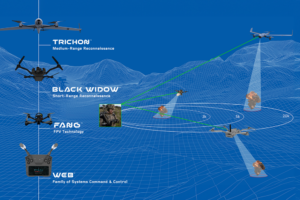 = Red Cat Holdings, Inc., a drone technology company building hardware and software for military, federal, and commercial operations, has introduced its ARACHNID family of unmanned intelligence, surveillance, and reconnaissance (ISR) and precision strike systems. Red Cat unveiled the Family of Systems at AUSA 2024 Annual Meeting and Exposition in Washington D.C. The ARACHNID family […]
= Red Cat Holdings, Inc., a drone technology company building hardware and software for military, federal, and commercial operations, has introduced its ARACHNID family of unmanned intelligence, surveillance, and reconnaissance (ISR) and precision strike systems. Red Cat unveiled the Family of Systems at AUSA 2024 Annual Meeting and Exposition in Washington D.C. The ARACHNID family […]
